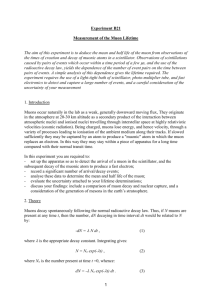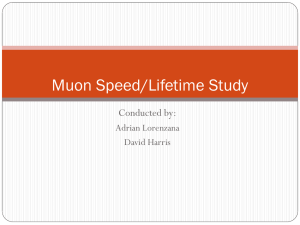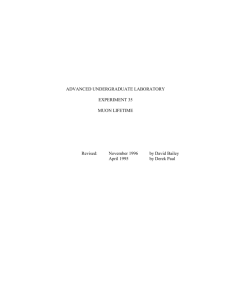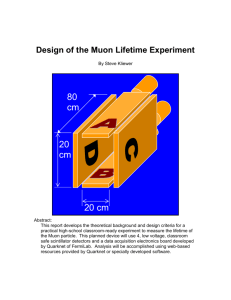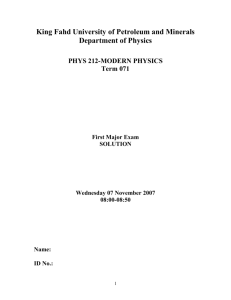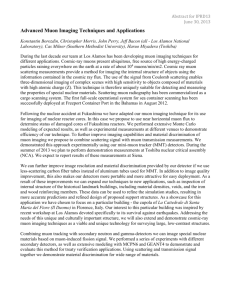The Proper Lifetime of the Muon
advertisement
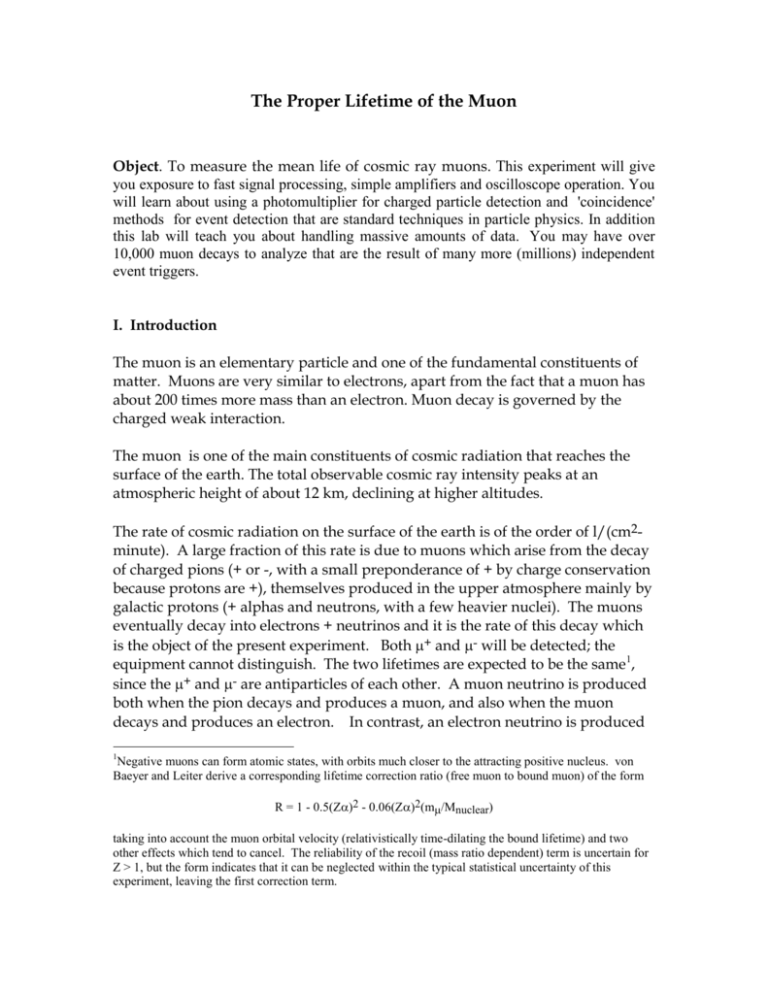
The Proper Lifetime of the Muon
Object. To measure the mean life of cosmic ray muons. This experiment will give
you exposure to fast signal processing, simple amplifiers and oscilloscope operation. You
will learn about using a photomultiplier for charged particle detection and 'coincidence'
methods for event detection that are standard techniques in particle physics. In addition
this lab will teach you about handling massive amounts of data. You may have over
10,000 muon decays to analyze that are the result of many more (millions) independent
event triggers.
I. Introduction
The muon is an elementary particle and one of the fundamental constituents of
matter. Muons are very similar to electrons, apart from the fact that a muon has
about 200 times more mass than an electron. Muon decay is governed by the
charged weak interaction.
The muon is one of the main constituents of cosmic radiation that reaches the
surface of the earth. The total observable cosmic ray intensity peaks at an
atmospheric height of about 12 km, declining at higher altitudes.
The rate of cosmic radiation on the surface of the earth is of the order of l/(cm2minute). A large fraction of this rate is due to muons which arise from the decay
of charged pions (+ or -, with a small preponderance of + by charge conservation
because protons are +), themselves produced in the upper atmosphere mainly by
galactic protons (+ alphas and neutrons, with a few heavier nuclei). The muons
eventually decay into electrons + neutrinos and it is the rate of this decay which
is the object of the present experiment. Both + and - will be detected; the
equipment cannot distinguish. The two lifetimes are expected to be the same1,
since the + and - are antiparticles of each other. A muon neutrino is produced
both when the pion decays and produces a muon, and also when the muon
decays and produces an electron. In contrast, an electron neutrino is produced
1
Negative muons can form atomic states, with orbits much closer to the attracting positive nucleus. von
Baeyer and Leiter derive a corresponding lifetime correction ratio (free muon to bound muon) of the form
R = 1 - 0.5(Z)2 - 0.06(Z)2(m/Mnuclear)
taking into account the muon orbital velocity (relativistically time-dilating the bound lifetime) and two
other effects which tend to cancel. The reliability of the recoil (mass ratio dependent) term is uncertain for
Z > 1, but the form indicates that it can be neglected within the typical statistical uncertainty of this
experiment, leaving the first correction term.
only by muon decay. Therefore the ratio of muon to electron neutrinos is about
2:1.
In order to measure the decay constant for a muon at rest (or the corresponding
mean-life) one must stop and detect a muon, wait for and detect its decay
products, and measure the time interval between capture and decay. Since
muons decaying at rest are selected, it is the proper lifetime that is measured.
Lifetimes of muons in flight are time-dilated (velocity dependent), and can be
much longer for = v/c ≈ 1.
Do a literature search to familiarize yourself with the theory of the muon decay.
You may also consult one of the references at the end of this writeup.
II. Apparatus
There are two experimental setups that employ different approaches to measure
the muon lifetime .
1. A commercial unit by teachspin.
2. A homebuilt unit.
You are required to do the experiment with the teachspin unit. The homebuilt
unit requires more calibrations and should only be attempted if there is more
time afterwards. However, you should still read the section on the homebuilt
unit because it is designed like the teachspin unit.
Teachspin experiment (~ 2 weeks)
Read the TeachSpin lab manual . It is reasonably complete and well written.
Follow the suggestions at the end of the lab manual and carry out exercises 1-13.
Use the function generator and oscilloscope to characterize the amplifier
properties. Connect the output of the function generator to the PMT input and the
oscilloscope (use the T-connector) and connect the Amplifier output to the second
oscilloscope channel.What is the amplifier gain? What is its allowable bandwidth
(frequency range)? Also compare the amplifier output with the discriminator output.
To get sufficient statistics for proper data analysis, you will need to acquire data
for several days.
From the Desktop of the computer, the data taking software is “Muon
Decay/Windows/muon_data/muon.exe.”
TeachSpin provides a few data analysis utilities that are quite helpful in sifting
through all the primary event triggers to get the number of actual muon decays. See the
manual for their description.
Notes:
1. The pulser switch on top of the detector controls an LED diode which simulates muon
events in the photomultiplier at a rate of 100Hz. This function is useful for initial set up
of the data collection parameters and for triggering the scope. Make sure to TURN OFF
the pulser during the actual muon data collection.
2. To collect data you will need to select COM3 in the Configure panel of the muon data
collection program. You also need to set a histogram scale and bin number. 12
microseconds and 20 bins is a reasonable choice.
Discussion and questions to include in lab report
1. At sea level, what is the total flux of muons and what is their average
energy in GeV? Given that the altitude of Serin is ~ 19m above sea level, estimate
the number of muons that enter your detector per unit time
This should allow you to estimate the expected number of decays per unit time in
your experiment. Compare this number to the rate you measured in the experiment.
Discuss your result.
2. Charged particles such as muons lose energy when traversing matter.
According to the Bethe-Bloch formula this energy loss is roughly constant for high
energy particles at about 2 MeV g−1 cm2. Estimate the energy loss of muons in the
atmosphere before reaching your detector? Note that 1 atm ~105 N/m2.
3. Do you expect to measure the same lifetime for positive and negative muons?
What are muonic atoms and why are negative muons much likelier to be captured
by the nucleus than electrons? The following article will help to understand this
problem: T. Suzuki, Total nuclear capture rates for negative muons, Physical
Review C35 (1987) 2212.
4. From the measured muon lifetime calculate the ratio of positive to negatively
charged muons that arrive at your detector.
5. From the measured muon lifetime calculate the Fermi coupling constant and
compare to accepted values.
6. A muon decays according to
+ --> e+ + e +
or - --> e- +
e +
What is the maximum momentum (in units of MeV/c) that the electron
can have, assuming the muon was initially at rest?
The muon mass is about 105 MeV; mass of the electron is about 0.5 MeV.
Assume neutrinos of all three types (electron, muon and tau) are massless,
although this is currently in question.) What is the minimum momentum
the electron can have?
7. Home-built experiment (optional ~ 2 weeks)
Apparatus
Three plastic scintillation counters with 8 photomultiplier tubes, Stanford
Research Systems PS325/2500V-25W regulated high voltage power supplies (2)
w/ voltage distribution boxes, Datapulse 109 pulse generator, Tektronix 2235A
100 MHz oscilloscope, LeCroy 623B octal discriminator w/width and threshold
adjustment, LeCroy 465 triple coincidence unit (4 ands, 1 veto), Canberra 2143
Time Analyzer, Canberra 2071A Dual Counter/Timer, Canberra Series 30
multichannel analyzer/scaler, Panasonic KX P1180 multimode printer w/MCA
adapter
Experimental arrangement
1. Detectors
The detectors are plastic scintillation counters in a vertical telescope
arrangement: two thin "passing" counters and one thick "stopping" counter.
As charged particles, such as muons, pass through these counters they lose
energy and cause the plastic to emit light (visible and UV), or scintillate. The
light is detected by photomultiplier tubes (primary photoelectron emission at
a photocathode coated with low work-function material, with subsequent
acceleration to successive "dynodes" where the accelerated electrons give up
their kinetic energy and several secondaries (typically 10/stage) are emitted
and accelerated in turn toward the next dynode. This high-gain cascade
process results in fast negative electrical signal pulses at the collecting anode,
which are processed (without prior amplification) by the discriminators,
which generate standard negative pulses for input to the fast coincidence
circuits. The set-up is shown below. One of the neutrinos (anti-neutrinos)
produced in the decay will be of electron type, the other, of muon type. There
is a third type-tau. It is believed that there may be no more.
2. Phototubes
The phototube specification sheet includes the following data:
• Type XP2262 (19 pin base); 12 stage (linear-focused, Cu-Be dynodes)
with capacitances: anode to final dynode - ≈ 3pF, anode to all ≈ 5 pF;
• 44 mm useful diameter head-on photocathode with lime-glass (n =
1.54) at 400±30 nm) plano-concave window, semi-transparent bi-
alkaline type D photocathode (maximum spectral sensitivity at 400 nm
(≈ 80 mA/W), high cathode sensitivity (25% quantum efficiency at 400
nm, blue sensitivity 10.5 A/lmF);
• very good linearity and timing characteristics, good single-electron
spectrum resolution (70%), 3x107 gain at 1850 volts, pulse amplitude ≈
7.2% resolution for 137Cs (cylindrical Quartz et Silice # 7256 NaI, 44
mm diameter and 50 mm high, ≈ 1000 cps), anode rise time ≈ 2.0 ns,
(with voltage divider B), linear to ≈ 100 mA with voltage divider A and
to ≈ 250 mA with voltage divider B;
• rise time, pulse duration and transit time variation ≈ V1/2;
•
for high-energy physics experiments, interchangable with XP2232;
• 50% anode curent reduction (1400 V, voltage divider A, uniform
cathode illumination) for magnetic fields of
• 0.2 mT perpendicuar to transverse axis a (see diagram, pins 5-15, 19
pin base) and 0.1 mT parallel to axis a, (mu-metal shield
recommended with 15 mm protrusion beyond photo cathode).
The phototube base has four coaxial connectors; two are bridged anode
outputs; two are high voltage supply inputs for the dynode voltage-divider
resistor string. Of these, one feeds all resistors, the other (unused, except at
high rates) can add an additional supply current capability to later-stage
(higher current) dynodes for prevention of voltage droop.
The phototubes are coupled to the scintillator with high-viscosity DowCorning 20-057 optical coupling compound.
It is well worth while reading the additional spec-sheet comments, for the
light they throw on tube operating characteristics and parameters.
2. Signals, electronics and logic
Various types of signal-generating events are shown below. In the present
configuration there are two phototubes each viewing the top and bottom
scintillators (one at each end) and four viewing the thick, central "stopping"
scintillator (two at each end). Not all are presently in use, and the discussion
below assumes one active phototube each for the thin detectors, and two for
the central scintillator. Extension to more detector signals is straightforward.
a. The 1st particle, a muon, produces signals in scintillator A and (2 signals)
in B. There is no signal in C since the muon comes to rest in B. This first
("start") condition is written AB C , read (AB notC). The decay electron
produces (at some later time) a second signal in B. The neutrino and
antineutrino (of types appropriate to + or - decay) have such weak
interaction that they always escape the scintillator without any energy
loss. Since the electron energy is relatively low it seldom leaves, and
hence usually causes no signals in A or C. This second ("stop") condition
is written AB C (A,B, notC) and A B C (notA, B, notC) constitute valid
start and stop signals respectively, as discussed further below.
Here, B denotes two coincident signals, which may be designated E1 and
E2 ("energy" signals).
b. The 2nd particle produces a false start: AB C . This will normally not be
followed by a valid stop pulse within the chosen processing time.
c. The 3rd particle satisfies the condition ABC which is neither a start nor a
stop, and is not of interest.
d. The 4th particle coming to rest in B produces a false stop: A B C .
To recapitulate, a muon is to be stopped in the large counter and the
subsequent decay electron is to be detected. As discussed above, the
signal of a stop in counter B of a muon coming from above is pulses from
scintillators A and B (B denotes two coincident signals, in configuration
under discussion), but not from C. This requirement is written as AB C ,
the box denoting the absence or “veto” of a signal. (A simultaneous signal
in C would mean a muon has gone through the apparatus but has not
been stopped). When the requirement (A,B notC) is obtained a muon has
presumably come to rest in counter B and a “start” pulse is generated to
begin a clock. When the decay electron is detected in counter B, the clock
is stopped. The logic for this is
A B C . i.e. notA, notC but only B. If
only B rather than A B C . were required, a stop could be faked by, for
example another unrelated muon going through all three counters. Since
only a small fraction of the muons going through the apparatus stop in
counter B, it is important to suppress this stop background with A and
C requirements. Most muons go through all three counters.
It is the function of the coincidence units (one each for start and stop
testing with each four-fold, since scintillator B has two associated
photomultiplier tubes) to determine that the start and stop logic is (or is
not) satisfied within the resolving time of the units. Coincidence circuit
resolving time is determined by the pulse width of the coincidence input
pulses from the discriminators, typically about 20 nanoseconds. Outputs
(start or stop) to the TAC occur if the inputs overlap in time. Therefore
the pulse delay associated with an extra six to ten feet of cable for one
photomultiplier signal output can cause loss of almost all valid signals.
The "delay matching" needed for maximum overlap can be checked most
easily in pairs using a pulser input (instead of the phototube output)
"teed" to successive pairs of cables, keeping a particular one as reference.
The advantage of using a pulser is that the rate can be set high enough
(400 kHz or more) to see the two pulses at the end of the cables (i.e. at
coincidence circuit input) easily on a normal oscilloscope. (Alternatively,
a storage scope can be used at the low muon rates.) Time offsets can be
negated by addition (or subtraction) of cable in one leg. Discriminator
output pulse widths can be checked at the same time.
All timing pulses (PMT output, discriminator output, coincidence
outputs) are negative. The PMT pulse is directly from the anode, without
pre-amplification.
The "clock" in this experiment will be a time-to-amplitude converter or
TAC. This instrument requires two short negative inputs, a "start" and a
"stop". The output of the TAC is a positive square pulse whose height or
amplitude is proportional to the time difference between the start and
stop pulses (a maximum of 10 volts, for t equal to the chosen maximum
time before TAC reset). This output is fed into the high-level input of a
multichannel pulse height analyzer (MCA) which sorts and stores the
pulses in a number vs. pulse-height (TAC time-interval analog output
pulse) histogram. Small TAC output pulses [small (stop - start) time
intervals] go into low MCA channels, large pulses into high channels. The
end result is a decay time spectrum of the muon, the horizontal axis or
channel number representing a time interval t and the vertical axis
representing number of pulses N. The time interval during which the
number decreases to 1/e of the initial value is defined as the mean life .
This is the inverse slope of a semi-log (natural log, not log10) plot of N vs.
t, if the decay spectrum follows the usual statistical radioactive law for the
decay of a single radioactive parent. The probability of a decay during
time interval dt is the product
(probability P of survival of the parent to time t)
x (probability {-dt} of decay during time interval dt
which latter is independent of t :
Eq. 1
dP = -P(dt) ---->
P = P0e-t = P0e-t/ .
3. Experimental procedure
a. Initial setup
Before the muon lifetime can be measured, the apparatus must be optimized
and calibrated. Normally, the discriminator pulse widths and thresholds and
the relstive signal timing (cable matching) will already have been done.
Check and sketch the various PMT signal relative timings and widths, using
the pulser for high rate and easy scope observation. This involves
successively disconnecting anode cables in pairs from the PMT's and
connecting them in parallel to the negative pulser output. (The pulser may
double pulse. If so, reduce the amplitude. This cannot be done for the
negative sync output; hence, don't use it.) Reference all other PMT signals to
that of the top scintillator (scintillator A). Set the scope to view both while
triggering on one; find the prior pulse by trial; set the pulser rate high enough
for easy scope observation.
Terminate scope inputs with 50 .
Fast pulses from the phototube anodes are sent directly to the fast
discriminator inputs without pre-amplification, in order to avoid degradation
of rise time, and therefore of timing resolution. Since the anode collects
electrons, the pulse is negative.
Use the fast oscilloscope to check the discriminator outputs for timing
coincidence. Use 50 nanosecond scope scale initially, and x10 pull-knob as
needed.
If timing is discordant, compensate for any significant relative shifts by
introducing (or subtracting) small cable lengths in the appropriate leg.
Connect the two discriminator outputs to the corresponding coincidence
inputs (switch out other coincidence conditions) and verify coincidences and
scaler operation.
(Estimate possible transit time shifts between counter #1 and #'s 2 and 3, for a
legitimate start pulse. At speed c, a muon will travel 30 cm/ns. A muon
which will come to rest in scintillator B will have lower speed. Energy loss in
B, for any speed, begins as soon as the particle enters. If the transit time shifts
are comparable to discriminator pulse widths, you will have to repeat the
cable delay matching using the low, actual muon pulse rates. A storage scope
might be useful.)
b. Voltage "plateauing"
It is normally not necessary to measure or vary the high voltage settings for
the photomultiplier tubes. If operation is unsatisfactory, the following
procedure may be followed. Natural (muon) pulses must be employed.
Set HV#1 to -1780 V (negative high voltage) and HV#2 to -1800V.
Vary #4 high voltage from -1100 V to -1300 in 50 V steps. Set the coincidence
unit to require #1 and #4 inputs only. First verify the coincidence timing,
then measure, record and plot the number of (1*4) coincidences/minute vs.
V4. Select an operating voltage for counter #4 which has minimum
sensitivity to voltage drift (center of "plateau"). Note this voltage for future
reference.
With the newly established #4 HV fixed, vary #1 HV and determine an
appropriate V1.
With #1 and #4 fixed, require (124) coincidence and find an appropriate V2 by
varying #2 HV.
With #'s 1, 2, and 4 HV fixed, require (1234) coincidence. and find V3 by
varying #3 HV. Record all selected voltages and include in your report for
future reference.
c. Discriminator settings
The TAC output rate due to unrelated pulses ("accidentals") is quite low, so
satisfactory lifetime determination is possible without further reduction of
coincidence circuit resolving time. If your instructor requests, proceed as
follows:
With HV's as established above, and viewing pulses with a storage
oscilloscope:
i. Use pulser inputs to reduce #'s 1 and 4 discriminator output widths to
20 nanoseconds; similarly reduce #'s 2 and 3 to 10 ns widths. (Pulses 1
and 4 are wider, since they are used as veto and must fully overlap
pulses 2 and 3) from detector B.
ii. Require (23) scintillator coincidences and vary the length of #2 cable by
+ 15 nanoseconds (by adding or subtracting signal cable) to obtain a
curve of coincidence counting rate vs. delay. The proper delay is in the
middle of the curve.
iiic. With proper (23) timing, require (123) coincidence and adjust the #1
delay.
iv. With proper (123) timing, require (1234) coincidence and adjust the #4
delay.
d. TAC-MCA calibration
Set the TAC to the 10 s scale (100 ns x 100). This will be several muon mean
lives. Be sure that the TAC inputs are terminated with 50 . (If TAC inputs
are viewed in parallel with a scope, terminate at the scope input only, and not
at the TAC inputs.) Set Gate = ANTI, Stop Inhibit = OFF, Delay = MIN,
Strobe = INT, Time SCA = OFF.
i. Delay generator method
This is preferred. Tee the negative pulser output (not the negative sync) to
1) an unused discriminator module, thence to the TAC start;
2) the delay box (negative input, fast output), thence to an unused
discriminator and to the TAC stop. (Taking the slow, negative delay
box output seems to produce double pulse response in the
discriminator.)
Connect the positive TAC output pulses to the MCA high level input.
Tee for parallel scope viewing of the start and stop input pulses. 50 ohm
termination at the scope inputs seems to produce less positive overshoot
than termination at the TAC inputs. Check for double pulsing; reduce
pulser amplitude if found.
Set the delay box on the 1 s scale. For successive settings between 1 and
8 microseconds store pulses in the MCA. Scan for the peak channel and
record channel vs. delay. Plot delay time vs. channel, store the data in a
KaleidaGraph file and and perform a linear fit. Save the KG data file.
Record the fit function for later use in converting your data channels to
time.
ii. Spacing of successive random pulses
With this arrangement a quick and interesting measurement can be made
of the distribution of time intervals between successive radioactive decay.
Set the TAC to 100 s range. Calibrate as before.
Maintaining the start as before, substitute for the pulser input to the delay
box the (0.1 - 10 volt) SCA output of a Canberra Amp/SCA having input
from a NaI scintillator irradiated by a gamma source. (Switch the delay
input to +). The delay setting is immaterial since the (regular) pulser
pulses have only a random time relation to the decay pulses.) Store,
adjusting the source rate (proximity) and pulser rate to observe an
exponential shape. Stop accumulation and record counts in 100 channel
bins, using the ROI. Record calibration (time, channel) and counting data
in a file. Record counting data (mean channel, counts/100 channels in the
same file. Perform a linear fit to the calibration using your favorite
software. Use the software to convert the data mean channels to time in
microseconds. Plot counts vs. time. Find the best non-linear least squares
fit.
iii. Scope time-base reference method
Produce a fairly high rate of start and stop signals with the pulser sync and
negative output signals (view with the oscilloscope) fed through two
discriminators and the two coincidence units, each set for singles (only one
input required for coincidence output).
Adjust the pulser delay for t ≈ 7 s, using the oscilloscope to view the two pulser
outputs while triggering with the earlier. Feed the TAC output into the high-level
input (bypassing the internal amplifier) of the multichannel analyzer, set for 1024
channel ADC conversion gain. Record the peak channel numbers and
corresponding start-stop time delays for several delays over the entire MCA
range, referring to the scope as your time reference. You should be able to read
the sync -out pulser time difference to a mm; use the maximum horizontal
separation of pulses on the scope (record this in mm and convert to time delay) to
minimize percentage error in your time calibration. Be sure the scope time base is
in calibrated position!
4. Measurement
Set the TAC for 10 s range. Record the total number of TAC starts and stops
(not valids) in the dual scalers (reset to zero at the beginning of data
accumulation). These will exceed the number of TAC outputs since a large
number of "starts" and "stops" are not real-they are spurious, unrelated
events. Since the TAC does not produce an output unless the start and stop
arrive within 10 microseconds of each other, most of these unrelated events
will be suppressed by the circuitry.
When the system is ready to collect data, arrange with any other users of the
MCA to collect data for a period of a few days. Check that the system is
indeed storing data before leaving the system to collect unattended. (The
counting rate should be around 5 per minute.) Turn down the MCA display
intensity and leave a note that an experiment is running. Record the data
collection start and stop times for determination of average rates.
If time permits, interchange the inputs to the quad discriminator from the
upper and lower thin scintillators. (Consider reversed transit-time delays will this affect the possibility of detecting decays of muons incident from
below?) This is equivalent to looking for stopping muons incident from below
(through the earth)?) Collect data for a similar time (a few days). (Reconnect
as before when finished.)
Restore the original input connections. If time permits, add 64 ns delay to the
counter 1 coincidence input (then all start inputs will be accidental, stops will
be true + accidental). Run at least overnight to determine the rate of this kind
of TAC accidental.
Remove the 64 ns delay and run in a 1234 coincidence mode (switch the lower
thin counter from a no to a yes), to estimate the total muon flux passing thru
the entire telescope.
5. Analysis
Review the material on fitting of an exponential decay in the section on Data
Acquisition and Analysis.
Add adjacent channels by setting successive regions of interest (ROI's) on the
MCA, to reduce the number of data points to fit and make a semi-log plot.
Every 50 channels should do. (Convince yourself that this does not alter the
slope of an exponential function, if all ROI's have the same number of
channels.) Don't include any initial channels with electronically cut off low
counts.
a. Linearized fit
Since the decay is expected to be exponential, the points in the decay
spectrum should lie on a straight line (neglecting background) in a plot of
ln(N) vs. t (or channel #). (Note that a semilog plot of log10(N) vs t will give
a slope differing from by log(e), with corresponding discrepancies in
and T1/2.) Fit the best straight line to a plot of the points and, from the slope
of the line (decay constant = 1/) , infer the mean-life and half life T1/2 of
the muon, and corresponding uncertainties.
b. Nonlinear Fit
Using KaleidaGraph or other non-linear chi-square minimization program
to fit a plot of counts vs. time (convert channels to time using your earlier
calibration) , determine the multiplicative parameter, muon mean life (=
1/decay constant) and constant background from your data (three
parameter fit). Perform both weighted (sqrt(counts)) and unweighted fits.
You will have to specify starting parameters, which can be obtained by
observation from your plot. Include in your report the best fit parameters
and their errors. Calculate the discrepancy between your weighted best fit
mean life and the accepted value of 2.19703 ± 0.00004 microseconds
6. Discussion
l. Comment on the differences and similarities between the two experimental
setups you used to measure the lifetime of the muon. Discuss the
advantages and disadvantages of each method.
2. A muon decays according to
+ --> e+ + e +
or - --> e- +
e +
What is the maximum momentum (in units of MeV/c) that the electron
can have, assuming the muon was initially at rest? (The muon mass is
about 105 MeV; mass of the electron is about 0.5 MeV. Assume neutrinos
of all three types (electron, muon and tau) are massless, although this is
currently in question.) What is the minimum momentum the electron can
have?
(According to the New York Times of Tuesday, October 25, 1995, a Los
Alamos experiment suggests the existence of a finite e mass (0.5 - 5 eV).
3. Two negative logic levels A and B are applied to a two-fold coincidence
circuit to produce an output, i.e. an output is produced if both A and B are
present, written AB. Show graphically that if B is complemented (as
explained earlier) to form B , then the coincidence circuit will behave like
a veto circuit on B, i.e. an output is produced if A but not B is present,
AB .
Figure 4
Logic Signals
4. Two uncorrelated rates R1 and R2 (per sec ) are used to start and stop a
TAC. If the live time of the TAC is 10 xl0-6 seconds (the effective resolving
time), calculate the TAC output rate. Use the scaler record of the number
of start and stop pulses, divided by data collection time, as Rl and R2.
Estimate the number of "false" events in your decay spectrum. How does
this number compare with the total number of events in your decay
spectrum? (See the discussion for the --angular correlation experiment
of accidentals in the coincidence method .)
5. What changes in apparatus or technique might improve the measurement
of the muon lifetime?
References
1. Serway, Moses and Moyer: Modern Physics, p 13 (lifetime of moving
muon); pp444-456 (elementary particles, leptons)
2. D.H. Perkins, Introduction to High Energy Physics,
3. D.W. Preston & E.R. Dietz: The Art of Experimental Physics; Appendix BCounting and Sorting Particles: The Scintillation Counter
4. C.S. Sutton, DA. MacIntire and S.J. Egan: Undergraduate Cosmic Ray
Muon Decay Experiments with Computer Interfacing; Computers in
Physics, Nov/Dec 1987, p76-79
5. M.W. Friedlander: Cosmic Rays , Harvard, 1989
6. T. K. Gaisser: Cosmic Rays and Particle Physics, Cambridge, 1990
7. A. Franklin: The appearance and disappearance of the 17-keV neutrino,
Rev. Mod. Phys. 67, #2, (April 1995), pp 457 - 490
8. G. Bardin et al: A New Measurement of the Positive Muon Lifetime,
Physics Letters v137B, number 1,2 (22 March, 1984)
9. Scientific American March '96, v 27 #3, p16: Tracking the Origin of Cosmic
Rays
10. Physics Today, February '96, v 49 #2 : Evidence of Cosmic Ray
Acceleration in a Supernova Remnant
